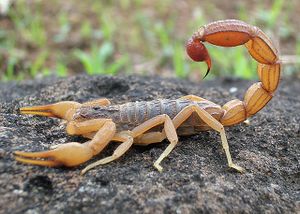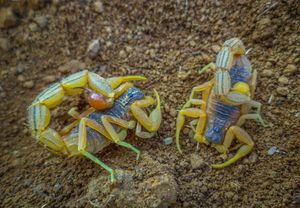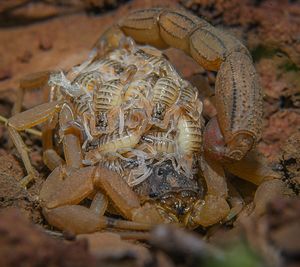العقرب الأحمر الهندي
| العقرب الأحمر الهندي | |
|---|---|

| |
| Hottentotta tamulus from Mangaon, Maharashtra, India | |

| |
| Hottentotta tamulus from Satara, Maharashtra, India | |
| التصنيف العلمي | |
| مملكة: | |
| Phylum: | |
| Subphylum: | |
| Class: | |
| Order: | |
| Family: | |
| Genus: | |
| Species: | H. tamulus
|
| Binomial name | |
| Hottentotta tamulus | |
| Synonyms[1] | |
| |
Hottentotta tamulus, the Indian red scorpion (Tamil: செந்தேள்; also known as the eastern Indian scorpion), is a species of scorpion belonging to the family Buthidae. It occurs in most of India,[2] eastern Pakistan[1] and the eastern lowlands of Nepal,[3] and recently from Sri Lanka.[4]
. . . . . . . . . . . . . . . . . . . . . . . . . . . . . . . . . . . . . . . . . . . . . . . . . . . . . . . . . . . . . . . . . . . . . . . . . . . . . . . . . . . . . . . . . . . . . . . . . . . . . . . . . . . . . . . . . . . . . . . . . . . . . . . . . . . . . . . . . . . . . . . . . . . . . . . . . . . . . . . . . . . . . . . .
Taxonomy
This species was named Scorpio tamulus by J.C. Fabricius in 1798.[5] The species name was apparently derived from the occurrence in the state/province of the Tamil people of south-eastern India. It was later often referred to the genera Buthus or Mesobuthus, although it was already correctly placed in Hottentotta by A. A. Birula in 1914,[6] a referral that was confirmed again by F. Kovařík in 2007.[1] Nevertheless, the binomen Mesobuthus tamulus is traditionally widespread in the popular and scientific literature. R.I. Pocock (1900)[7] distinguished five subspecies according to coloration and distribution, but these are color-morphs (individuals with varying color) rather than subspecies.[1]
Description
H. tamulus specimen range in size from 50–90 mm. The coloration ranges from dark orange or brightly red-brown through dull brown with darker grey carinae (ridges) and granulation. Grey spots might be distributed irregularly across the cephalothorax and the mesosoma. The walking legs and the tip of the pedipalp pincers are brighter colored (orange-yellow to light reddish-brown). The mesosomal tergites always bear three distinct carinae. Their habitus is typical of buthid scorpions, with rather small pedipalp pincers, moderately thickened metasomal segments and a rather bulbous telson with large stinger. The base of the pedipalp pincers (manus) is slightly more inflated in males than in females.[1]
Toxicity
This species is of great medical significance in densely populated areas of India and Nepal and occasionally causes human fatalities.[3][8][9] Fatality rates of 8–40% have been reported in clinical studies; most victims are children.[8][10]
Symptoms of envenomation by this species include:[3][8][9][11]
- Severe local pain
- Vomiting
- Sweating
- Priapism
- Cyanosis
- Unconsciousness
- Muscular convulsions
- Breathlessness
- Pink frothy sputum
- Abnormal heart rhythms
- A fast or slow heart rate
- Low or high blood pressure
- Acute myocarditis
- Shock
The venom mainly affects the cardiovascular and pulmonary system, eventually leading to a pulmonary oedema, which may cause death.[8][9] Scorpion antivenom has little effect in clinical treatment but application of prazosin reduces the mortality rate to less than 4%.[9][12] As in other scorpions, the venom of H. tamulus consists of a complex mixture of proteins. Some major components have been isolated, including the toxin tamapin. Scorpion envenomation with high morbidity and mortality is usually due to either excessive autonomic activity and cardiovascular toxic effects or neuromuscular toxic effects. Antivenin is the specific treatment for scorpion envenomation combined with supportive measures including vasodilators in patients with cardiovascular toxic effects and benzodiazepines when there is neuromuscular involvement. Although rare, severe hypersensitivity reactions including anaphylaxis to scorpion antivenin (SAV) are possible.[13]
Habitat and ecology
Despite its medical importance, little is known about the ecology and habitat preferences of this species.[9] It is widespread across vegetated lowlands with subtropical to tropical, humid climate and often lives close to or in human settlements, especially in rural areas. A study[14] from Saswad-Jejuri, Pune (western India) has found H. tamulus in a wide range of microhabitats, including scrubland and veld with stones, red and black soil in cropland, loamy, grassy and stony hillslopes and -tops, black soil in mango orchards, Eucalyptus plantations, and under tree bark. With an abundance of 48.43% it was by far the most abundant of the six scorpion species recorded in this study. It occurs rather seldom under tree bark, a habitat dominated by its sister species Hottentotta pachyurus (8.9% versus 91.1% abundance). As all other scorpions, H. tamulus is nocturnal, preying upon small invertebrates and even small vertebrates like lizards.[15] Encounters with humans mainly occur during the night or early morning, when the scorpions accidentally crawl into beds or fall from ceilings.[9]
In Sri Lanka
Originally, H. tamulus was not found in Sri Lanka. But from 2010 to 2013, experiments and other medical reports suggest that the species is also present in Sri Lanka. Few deaths were recorded from Jaffna peninsula in recent times. After observing medical reports and patients, a research team found three dead scorpion specimens and five live specimens as well. After series of observations from research team and other international scientists, it was revealed that the scorpion specimens belong to the species H. tamulus.
Deaths from H. tamulus were recorded in 2006, 2007 and 2009 as one patient per year. No cases were recorded in 2010. In 2011, 12 children in Jaffna died due to H. tamulus stings. In 2012, 80 patients were recorded. Out of them, 52% were female, 48% were male. 30% from them were children between the age 3 and 12.[4]
In 2013, many H. tamulus stings were recorded, as many as four each week, again mostly in women and children. Usually, the drug Prazosin is recommended for H. tamulus stings. The drug can reduce the increasing blood pressure.
See also
Notes
- ^ No specimen number specified.
External links
- Images of various Hottentotta species, including H. tamulus: Hottentotta.com.
- Video: "World's Deadliest Scorpion?" Nationalgeographic.com
- http://scorpion-files.blogspot.com/2013/03/first-report-of-medical-important.html
- https://web.archive.org/web/20130529041204/http://www.newsfirst.lk/english/node/22258
References
- ^ أ ب ت ث ج ح Kovařík, F. (2007). "A revision of the genus Hottentotta Birula, 1908, with descriptions of four new species" (PDF). Euscorpius. 58: 1–105. Retrieved 14 April 2010.
- ^ Bastawade, D.B.; S.S. Jadhav; R.M. Sharma (2012). Scorpionida (PDF). Zoological Survey of India. pp. 1–16. Archived from the original (PDF) on 17 September 2013. Retrieved 10 June 2019.
{{cite book}}: Unknown parameter|last-author-amp=ignored (|name-list-style=suggested) (help) - ^ أ ب ت Bhadani, U.K.; M. Tripathi; S. Sharma; R. Pandey (2006). "Scorpion sting envenomation presenting with pulmonary edema in adults: a report of seven cases from Nepal". Indian Journal of Medical Sciences. 60 (1): 19–23. doi:10.4103/0019-5359.19672.
{{cite journal}}: Unknown parameter|last-author-amp=ignored (|name-list-style=suggested) (help)CS1 maint: unflagged free DOI (link) - ^ أ ب Kularatne, Senanayake A.M.; Dinamithra, Nandana P.; Sivansuthan, Sivapalan; Weerakoon, Kosala G.A.D.; Thillaimpalam, Bhanu; Kalyanasundram, Vithiya; Ranawana, Kithsiri B. (January 2015). "Clinico-epidemiology of stings and envenoming of Hottentotta tamulus (Scorpiones: Buthidae), the Indian red scorpion from Jaffna Peninsula in northern Sri Lanka". Toxicon. 93: 85–89. doi:10.1016/j.toxicon.2014.11.225.
- ^ Fabricius, F. C. (1798). Entomologiae Systematicae, Supplementum (in Latin). Vol. 5. Hafniae: Proft & Storck. p. 572. Retrieved 14 April 2010.
{{cite book}}: CS1 maint: unrecognized language (link) - ^ Birula, A. A. (1914). "Ergebnisse einer von Prof. Franz Werner im Sommer 1910 mit Unterstützung aus dem Legate Wedl ausgeführten zoologischen Forschungsreise nach Algerien. VI. Skorpione und Solifugen" [Results of a zoological expedition to Algeria carried out by Prof. Franz Werner in the summer of 1910 with support from Legate Wedl. VI. Scorpions and solifuge]. Sitzungsberichte der kaiserlich-königlichen Akademie der Wissenschaften, Wien (in German). 123 (1): 633–668.
{{cite journal}}: CS1 maint: unrecognized language (link) - ^ Pocock, R.I. (1900). Arachnida. The Fauna of India, including Ceylon and Burma. London: W.T. Blandford. pp. xii+279.
- ^ أ ب ت ث Bawaskar, H.S.; P.H. Bawaskar (1998). "Indian red scorpion envenoming". Indian Journal of Pediatrics. 65 (3): 383–391. doi:10.1016/0041-0101(95)00005-7. PMID 10771989.
- ^ أ ب ت ث ج ح Bawaskar, H.S.; P.H. Bawaskar (2008). "Scorpion sting: A study of clinical manifestations and treatment regimes" (PDF). Current Science. 95 (9): 1337–1341.
- ^ Bawaskar, H.S. (1977). "Scorpion sting and cardiovascular complications". Indian Heart Journal. 29: 228.
- ^ Kanoo, S.; M. B. Mandal; A. B. Alex; S. B. Deshpande (2009). "Cardiac dysrhythmia produced by Mesobuthus tamulus venom involves NO-dependent G-Cyclase signaling pathway". Naunyn-Schmiedeberg's Archives of Pharmacology. 379 (5): 525–532. doi:10.1007/s00210-008-0375-7.
{{cite journal}}: Unknown parameter|last-author-amp=ignored (|name-list-style=suggested) (help) - ^ Bawaskar, H.S.; P.H. Bawaskar (2007). "Utility of scorpion anti-venin vs. prazosin in the management of severe Mesobuthus tamulus (Indian red scorpion) envenoming at rural settings" (PDF). Journal of the Association of Physicians of India. 55: 14–21. Retrieved 14 April 2010.
- ^ Bhoite RR, Bhoite GR, Bagdure DN, Bawaskar HS (2015). "Anaphylaxis to scorpion antivenin and its management following envenomation by Indian red scorpion, Mesobuthus tamulus". Indian Journal of Critical Care Medicine. 19 (9): 547–549. doi:10.4103/0972-5229.164807. PMC 4578200.
{{cite journal}}: CS1 maint: unflagged free DOI (link) - ^ Pande, S.; D. Bastawade; A. Padhye; A. Pawashe (2012). "Diversity of scorpion fauna of Saswad-Jejuri, Pune district, Maharashtra, western India" (PDF). Journal of Threatened Taxa. 4 (2): 2381–2389.
{{cite journal}}: Unknown parameter|last-author-amp=ignored (|name-list-style=suggested) (help) - ^ Ythier, E. (2007). "Pictures of the previous months". The Scorpion Fauna. Retrieved 14 April 2010.

